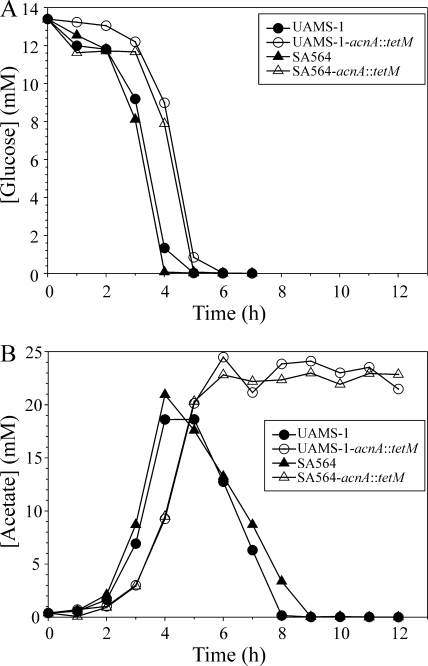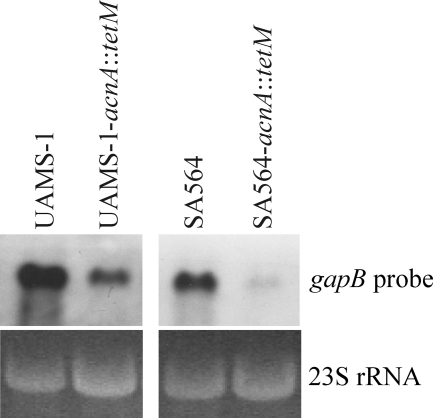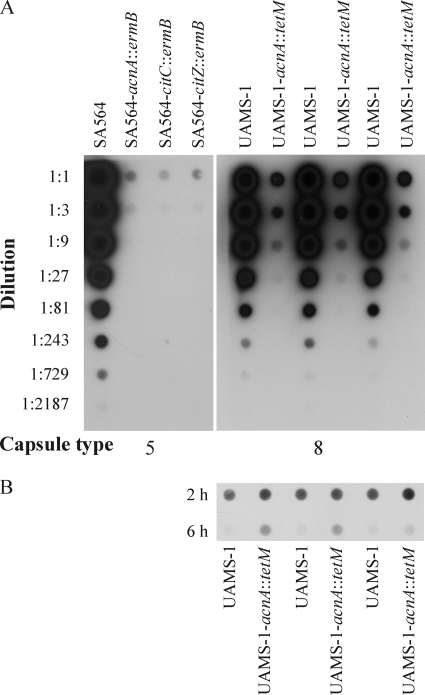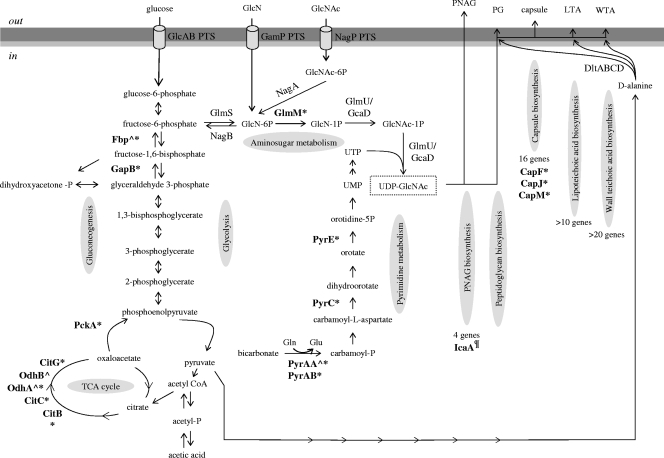Abstract
Staphylococcus aureus capsule synthesis requires the precursor N-acetyl-glucosamine; however, capsule is synthesized during post-exponential growth when the availability of N-acetyl-glucosamine is limited. Capsule biosynthesis also requires aerobic respiration, leading us to hypothesize that capsule synthesis requires tricarboxylic acid cycle intermediates. Consistent with this hypothesis, S. aureus tricarboxylic acid cycle mutants fail to make capsule.
Staphylococcus aureus produces two major exopolysaccharides: poly-N-acetylglucosamine (PNAG) and capsule. PNAG is synthesized by enzymes encoded by genes within the intercellular adhesin (ica) operon (icaADBC) (5, 15) during the exponential growth phase when C6 carbohydrates are abundant (5, 10, 12). In contrast, capsular polysaccharides are predominantly synthesized during the post-exponential growth phase when C6 carbohydrates are in short supply (13). The most commonly encountered S. aureus capsule types, 5 and 8, are synthesized from the amino sugars N-acetyl-d-fucosamine, N-acetyl-l-fucosamine, and N-acetyl-d-mannosaminuronic acid (17). Interestingly, the biosynthetic precursor of the capsular sugars is UDP-N-acetylglucosamine (11), the same amino sugar used in synthesizing PNAG. N-acetylglucosamine is synthesized from the glycolytic intermediate fructose 6-phosphate, and in a rich medium containing glucose, abundant levels of fructose 6-phosphate will be generated by glycolysis. As stated, capsule is most abundantly synthesized in the post-exponential phase of growth when glucose is growth limiting (4, 13).
In the absence of glucose, fructose 6-phosphate can be synthesized by gluconeogenesis from the tricarboxylic acid (TCA) cycle intermediate oxaloacetate. To do this, oxaloacetate undergoes an ATP-dependent decarboxylation and phosphorylation by phosphoenolpyruvate carboxykinase (pckA) to generate phosphoenolpyruvate (PEP) (19). Gluconeogenesis can then generate fructose 6-phosphate from PEP, which can be used for UDP-activated N-acetylglucosamine biosynthesis. Support for the idea that post-exponential-phase capsule biosynthesis requires TCA cycle activity and PEP carboxykinase can be found in the observation that capsule is made during aerobic growth (6). In the Dassy and Fournier study, respiratory chain inhibitors were used to show that respiratory activity or a high proton motive force is required for post-exponential-growth-phase capsule biosynthesis (6). Although this was an excellent study, it was unclear as to why inhibiting respiratory activity prevented capsule biosynthesis. One consequence of inhibiting respiratory activity is the accumulation of reducing potential in the form of NADH. As NADH accumulates, the intracellular concentration of NAD+ decreases and the activity of NAD+-requiring enzymes similarly decreases. During the post-exponential growth phase, the primary consumer of NAD+ is the TCA cycle; therefore, inhibiting respiratory activity inhibits TCA cycle activity. Further support that post-exponential capsule biosynthesis requires TCA cycle activity can be seen in transposon mutagenesis studies that found inactivation of PEP carboxykinase, the TCA cycle (citB, citC, citG, or odhA), or N-acetylglucosamine biosynthesis (glmM) reduces killing in a Caenorhabditis elegans killing assay to the same extent as do mutations in capsule genes (1, 2). Despite these observations suggesting that TCA cycle activity is required for capsule biosynthesis, capsule accumulation has never been measured in TCA cycle-deficient S. aureus strains. The objective of this study was to determine if TCA cycle activity was required for the biosynthesis of capsule types 5 and 8.
To determine if TCA cycle activity was required for S. aureus capsular polysaccharide biosynthesis, the amount of capsule produced by wild-type strains SA564 and UAMS-1 was compared to that produced by isogenic aconitase mutant strains SA564 acnA::ermB and UAMS-1 acnA::tetM. (Strains UAMS-1 and SA564 are low-passage, human isolates recovered from patients with osteomyelitis or toxic shock syndrome, respectively [8, 20].) In addition, to make certain that any differences in capsule accumulation were not specific to the aconitase gene, the genes coding for citrate synthase (citZ) and isocitrate dehydrogenase (citC) were inactivated in strain SA564, and the ability of these mutants to produce capsule was also determined. All TCA cycle mutants were constructed as previously described (18, 21, 25) by replacing acnA-citB, citZ, or citC in the capsule type 5-producing strain SA564 and acnA-citB in the capsule type 8-producing strain UAMS-1 with a tetM or ermB cassette. To minimize the possibility that any phenotypes were the result of random mutations occurring during temperature shifts, all mutations were backcrossed into the appropriate wild-type strain by using transducing phage 85 (16). Genetic inactivation of each gene was confirmed by PCR, Southern blotting (data not shown), and phenotypic assays. The phenotypic assays consisted of enzyme assays (i.e., aconitase, isocitrate dehydrogenase, and citrate synthase [22]), growth curves, and measuring the glucose and acetate concentrations present in the culture medium over time (Fig. 1 and data not shown). Acetate and glucose concentrations were determined with kits purchased from R-Biopharm and used according to the manufacturer's protocol. As expected, inactivation of the TCA cycle did not impair glucose catabolism; however, it completely inhibited the catabolism of acetate in all TCA cycle mutant strains. (In staphylococci, acetate catabolism requires a fully functioning TCA cycle [9, 21, 23].) The inhibition of acetate catabolism will decrease the availability of oxaloacetate and PEP, preventing gluconeogenesis. To assess the effect of TCA cycle inactivation on gluconeogenesis, Northern blot analysis was performed using a probe for the glyceraldehyde-3-phosphate dehydrogenase gene gapB. Although several enzymes involved in glycolysis and gluconeogenesis can function in the catabolic and anabolic directions, many bacteria, including staphylococci, use two distinct glyceraldehyde-3-phosphate dehydrogenase enzymes encoded by gapA (catabolic) and gapB (anabolic) (7); hence, gapB is an indicator of gluconeogenesis. Northern blots were preformed as previously described (18) using a PCR-generated gapB probe. During the post-exponential growth phase (6 h) when glucose is depleted and there is abundant acetate in the culture medium (Fig. 1B), the wild-type strains SA564 and UAMS-1 produced abundant transcript levels of gapB (Fig. 2). In contrast, the SA564 acnA::tetM and UAMS-1 acnA::tetM strains had dramatically decreased gapB mRNA levels relative to those of the wild-type strains (Fig. 2). As is normally the situation, there was strain-to-strain variation in the absolute amount of gapB mRNA present in these genetically distinct S. aureus strains (Fig. 2); however, the decreased level of gapB mRNA in the aconitase mutants relative to the wild-type strains was consistent. These data demonstrate that the normal post-exponential flow of carbon through the TCA cycle and gluconeogenesis is inhibited in TCA cycle mutants.
FIG. 1.
Glucose depletion (A) and acetate accumulation and depletion (B) in the culture supernatants of wild-type strains SA564 and UAMS-1 and aconitase SA564 acnA::tetM and UAMS-1 acnA::tetM mutant strains, plotted as a function of time. Bacterial cultures were grown in tryptic soy broth (Difco) at 37°C, with a flask-to-medium ratio of 10:1, and aerated at 225 rpm. The results are representative of three independent experiments.
FIG. 2.
Northern blot analysis of gapB (glyceraldehyde-3-phosphate dehydrogenase) at 6 h postinoculation. The results presented are representative of two independent experiments.
To determine if TCA cycle inactivation altered capsule biosynthesis, capsule accumulation was quantified from equivalent numbers of bacteria (1.25 optical density at 660 nm [OD660] units) grown overnight in tryptic soy broth, using capsule immunoblots essentially as described previously (14), except that immunoblots were developed using a chemiluminescent horseradish peroxidase (HRP) substrate (Millipore). Consistent with the hypothesis that post-exponential-growth-phase capsule biosynthesis requires TCA cycle activity, inactivation of any of the first three genes of the TCA cycle (citZ, acnA-citB, or citC) dramatically reduced capsule type 5 accumulation in strain SA564 (Fig. 3). Similarly, inactivation of the aconitase gene (acnA-citB) in strain UAMS-1 strongly inhibited capsule type 8 accumulation (Fig. 3A). To determine if TCA cycle inactivation impaired PNAG synthesis, PNAG immunoblot analyses were preformed as described previously (26). As expected, TCA cycle inactivation did not impair PNAG synthesis by strain UAMS-1 (Fig. 3B). (Strain SA564 does not produce PNAG under any growth conditions [C. Vuong and G. A. Somerville, unpublished observations]; thus, its ability to synthesize PNAG was not assessed.) These data demonstrate that the post-exponential-growth-phase biosynthesis of capsule requires TCA cycle activity.
FIG. 3.
TCA cycle activity is required for capsule biosynthesis but not for PNAG synthesis. (A) For the capsule blots, bacteria were harvested after overnight growth in tryptic soy broth at 37°C, with a flask-to-medium ratio of ∼20:1, and aerated at 225 rpm. Left panel, type 5 capsule immunoblot of wild-type strain SA564 and three TCA cycle mutants (citZ, citC, and acnA-citB mutants). The results are representative of experiments performed at least three times. Right panel, type 8 capsule immunoblot of wild-type strain UAMS-1 and the isogenic aconitase mutant strain UAMS-1 acnA::tetM. The results are from three independent experiments. (B) PNAG immunoblot of strains UAMS-1 and UAMS-1 acnA::tetM. PNAG immunoblot analyses were performed as described previously (26) on samples collected after 2 and 6 h of growth. The results are from three independent experiments.
During aerobic growth of S. aureus in a carbohydrate-containing medium, acetate accumulates in the medium until the carbohydrate concentration decreases to a level at which it can no longer sustain rapid growth (Fig. 1). The exit from the exponential phase of growth corresponds with the TCA cycle-dependent catabolism of acetate (21, 23). TCA cycle inactivation inhibits the post-exponential-growth-phase catabolism of acetate (Fig. 1), severely limiting the ability of S. aureus to generate oxaloacetate. Oxaloacetate is a dicarboxylic acid intermediate of the TCA cycle, and it is the substrate for PEP carboxykinase, which catalyzes the first committed step in gluconeogenesis to generate PEP. In the absence of PEP, S. aureus cannot drive hexose synthesis via gluconeogenesis (Fig. 2); hence, very little fructose 6-phosphate is made. When fructose 6-phosphate is in limiting supply, the ability of S. aureus to make UDP-N-acetylglucosamine, the precursor of capsular polysaccharides, is inhibited; thus, TCA cycle inactivation prevents capsule biosynthesis (Fig. 3A). In contrast to capsule biosynthesis, PNAG is synthesized during the exponential growth phase (Fig. 3B) when there is abundant glucose flowing through glycolysis and TCA cycle activity is repressed (18, 23, 24). In summary, the UDP-N-acetylglucosamine used in PNAG biosynthesis is derived from glycolysis, while the UDP-N-acetylglucosamine used in capsule biosynthesis is derived from gluconeogenesis (Fig. 4).
FIG. 4.
Schematic representation of metabolic genes and pathways important for UDP-N-acetylglucosamine, capsule, and PNAG biosynthesis. For comparison with previous work, boldface type indicates products of virulence-associated genes identified in C. elegans killing assays. ^, Begun-Sifri screen (2); *, Bae et al. screen (1); ¶, PNAG biosynthetic locus important for Staphylococcus epidermidis and S. aureus virulence (3). Mutants in committed steps of gluconeogenesis (PckA, GapB, Fbp), N-acetylglucosamine metabolism (GlmM/FemD), and UTP biosynthesis (PyrAA, PyrAB, PyrC, PyrE) suggest that UDP-N-acetylglucosamine is a pivotal metabolic intermediate. UDP-N-acetylglucosamine serves as a biosynthetic precursor for peptidoglycan, biofilm, capsule, and teichoic acids. Biofilm and capsule have been shown to be important in both nematode and mammalian infections by staphylococci.
Acknowledgments
G.A.S. was supported by funds provided through the Hatch Act and the Institute of Agriculture and Natural Resources. T.A.M. was supported in part by funds provided through the University of Nebraska's Undergraduate Creative Activities and Research Experiences. T.T.L. and C.Y.L. were supported by funds provided through the NIH (grant AI037027).
Footnotes
Published ahead of print on 8 January 2010.
REFERENCES
- 1.Bae, T., A. K. Banger, A. Wallace, E. M. Glass, F. Aslund, O. Schneewind, and D. M. Missiakas. 2004. Staphylococcus aureus virulence genes identified by Bursa aurealis mutagenesis and nematode killing. Proc. Natl. Acad. Sci. U. S. A. 101:12312-12317. [DOI] [PMC free article] [PubMed] [Google Scholar]
- 2.Begun, J., C. D. Sifri, S. Goldman, S. B. Calderwood, and F. M. Ausubel. 2005. Staphylococcus aureus virulence factors identified by using a high-throughput Caenorhabditis elegans-killing model. Infect. Immun. 73:872-877. [DOI] [PMC free article] [PubMed] [Google Scholar]
- 3.Begun, J., J. M. Gaiani, H. Rohde, D. Mack, S. B. Calderwood, F. M. Ausubel, and C. D. Sifri. 2007. Staphylococcal biofilm exopolysaccharide protects against Caenorhabditis elegans immune defenses. PLoS Pathog. 3:e57. [DOI] [PMC free article] [PubMed] [Google Scholar]
- 4.Chen, Z., T. T. Luong, and C. Y. Lee. 2007. The sbcDC locus mediates repression of type 5 capsule production as part of the SOS response in Staphylococcus aureus. J. Bacteriol. 189:7343-7350. [DOI] [PMC free article] [PubMed] [Google Scholar]
- 5.Cramton, S. E., C. Gerke, N. F. Schnell, W. W. Nichols, and F. Götz. 1999. The intercellular adhesion (ica) locus is present in Staphylococcus aureus and is required for biofilm formation. Infect. Immun. 67:5427-5433. [DOI] [PMC free article] [PubMed] [Google Scholar]
- 6.Dassy, B., and J. M. Fournier. 1996. Respiratory activity is essential for post-exponential-phase production of type 5 capsular polysaccharide by Staphylococcus aureus. Infect. Immun. 64:2408-2414. [DOI] [PMC free article] [PubMed] [Google Scholar]
- 7.Fillinger, S., S. Boschi-Muller, S. Azza, E. Dervyn, G. Branlant, and S. Aymerich. 2000. Two glyceraldehyde-3-phosphate dehydrogenases with opposite physiological roles in a nonphotosynthetic bacterium. J. Biol. Chem. 275:14031-14037. [DOI] [PubMed] [Google Scholar]
- 8.Gillaspy, A. F., S. G. Hickmon, R. A. Skinner, J. R. Thomas, C. L. Nelson, and M. S. Smeltzer. 1995. Role of the accessory gene regulator (agr) in pathogenesis of staphylococcal osteomyelitis. Infect. Immun. 63:3373-3380. [DOI] [PMC free article] [PubMed] [Google Scholar]
- 9.Goldschmidt, M. C., and D. M. Powelson. 1953. Effect of the culture medium on the oxidation of acetate by Micrococcus pyogenes var. aureus. Arch. Biochem. Biophys. 46:154-163. [DOI] [PubMed] [Google Scholar]
- 10.Götz, F. 2002. Staphylococcus and biofilms. Mol. Microbiol. 43:1367-1378. [DOI] [PubMed] [Google Scholar]
- 11.Kneidinger, B., K. O'Riordan, J. Li, J. R. Brisson, J. C. Lee, and J. S. Lam. 2003. Three highly conserved proteins catalyze the conversion of UDP-N-acetyl-d-glucosamine to precursors for the biosynthesis of O antigen in Pseudomonas aeruginosa O11 and capsule in Staphylococcus aureus type 5. Implications for the UDP-N-acetyl-l-fucosamine biosynthetic pathway. J. Biol. Chem. 278:3615-3627. [DOI] [PubMed] [Google Scholar]
- 12.Lim, Y., M. Jana, T. T. Luong, and C. Y. Lee. 2004. Control of glucose- and NaCl-induced biofilm formation by rbf in Staphylococcus aureus. J. Bacteriol. 186:722-729. [DOI] [PMC free article] [PubMed] [Google Scholar]
- 13.Luong, T., S. Sau, M. Gomez, J. C. Lee, and C. Y. Lee. 2002. Regulation of Staphylococcus aureus capsular polysaccharide expression by agr and sarA. Infect. Immun. 70:444-450. [DOI] [PMC free article] [PubMed] [Google Scholar]
- 14.Luong, T. T., S. W. Newell, and C. Y. Lee. 2003. Mgr, a novel global regulator in Staphylococcus aureus. J. Bacteriol. 185:3703-3710. [DOI] [PMC free article] [PubMed] [Google Scholar]
- 15.Maira-Litrán, T., A. Kropec, C. Abeygunawardana, J. Joyce, G. Mark, 3rd, D. A. Goldmann, and G. B. Pier. 2002. Immunochemical properties of the staphylococcal poly-N-acetylglucosamine surface polysaccharide. Infect. Immun. 70:4433-4440. [DOI] [PMC free article] [PubMed] [Google Scholar]
- 16.Novick, R. P. 1991. Genetic systems in staphylococci. Methods Enzymol. 204:587-636. [DOI] [PubMed] [Google Scholar]
- 17.O'Riordan, K., and J. C. Lee. 2004. Staphylococcus aureus capsular polysaccharides. Clin. Microbiol. Rev. 17:218-234. [DOI] [PMC free article] [PubMed] [Google Scholar]
- 18.Sadykov, M. R., M. E. Olson, S. Halouska, Y. Zhu, P. D. Fey, R. Powers, and G. A. Somerville. 2008. Tricarboxylic acid cycle-dependent regulation of Staphylococcus epidermidis polysaccharide intercellular adhesin synthesis. J. Bacteriol. 190:7621-7632. [DOI] [PMC free article] [PubMed] [Google Scholar]
- 19.Scovill, W. H., H. J. Schreier, and K. W. Bayles. 1996. Identification and characterization of the pckA gene from Staphylococcus aureus. J. Bacteriol. 178:3362-3364. [DOI] [PMC free article] [PubMed] [Google Scholar]
- 20.Somerville, G. A., S. B. Beres, J. R. Fitzgerald, F. R. DeLeo, R. L. Cole, J. S. Hoff, and J. M. Musser. 2002. In vitro serial passage of Staphylococcus aureus: changes in physiology, virulence factor production, and agr nucleotide sequence. J. Bacteriol. 184:1430-1437. [DOI] [PMC free article] [PubMed] [Google Scholar]
- 21.Somerville, G. A., M. S. Chaussee, C. I. Morgan, J. R. Fitzgerald, D. W. Dorward, L. J. Reitzer, and J. M. Musser. 2002. Staphylococcus aureus aconitase inactivation unexpectedly inhibits post-exponential-phase growth and enhances stationary-phase survival. Infect. Immun. 70:6373-6382. [DOI] [PMC free article] [PubMed] [Google Scholar]
- 22.Somerville, G. A., A. Cockayne, M. Dürr, A. Peschel, M. Otto, and J. M. Musser. 2003. Synthesis and deformylation of Staphylococcus aureus delta-toxin are linked to tricarboxylic acid cycle activity. J. Bacteriol. 185:6686-6694. [DOI] [PMC free article] [PubMed] [Google Scholar]
- 23.Somerville, G. A., B. Saïd-Salim, J. M. Wickman, S. J. Raffel, B. N. Kreiswirth, and J. M. Musser. 2003. Correlation of acetate catabolism and growth yield in Staphylococcus aureus: implications for host-pathogen interactions. Infect. Immun. 71:4724-4732. [DOI] [PMC free article] [PubMed] [Google Scholar]
- 24.Vuong, C., J. B. Kidder, E. R. Jacobson, M. Otto, R. A. Proctor, and G. A. Somerville. 2005. Staphylococcus epidermidis polysaccharide intercellular adhesin production significantly increases during tricarboxylic acid cycle stress. J. Bacteriol. 187:2967-2973. [DOI] [PMC free article] [PubMed] [Google Scholar]
- 25.Zhu, Y., E. C. Weiss, M. Otto, P. D. Fey, M. S. Smeltzer, and G. A. Somerville. 2007. Staphylococcus aureus biofilm metabolism and the influence of arginine on polysaccharide intercellular adhesin synthesis, biofilm formation, and pathogenesis. Infect. Immun. 75:4219-4226. [DOI] [PMC free article] [PubMed] [Google Scholar]
- 26.Zhu, Y., Y. Q. Xiong, M. R. Sadykov, P. D. Fey, M. G. Lei, C. Y. Lee, A. S. Bayer, and G. A. Somerville. 2009. Tricarboxylic acid cycle-dependent attenuation of Staphylococcus aureus in vivo virulence by selective inhibition of amino acid transport. Infect. Immun. 77:4256-4264. [DOI] [PMC free article] [PubMed] [Google Scholar]






